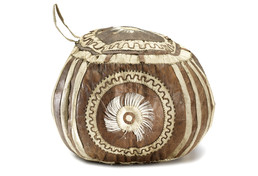f. Gaming Balls
–Sarah Diver
Inupiaq games
The most suitable times of the year for playing football games were during the transitional seasons of spring and fall, before communities moved to summer or winter houses to hunt seasonal game, and while the days were still longer.[1] During the last segment of the Messenger Feast, called the katnut or trading festival, many sporting games were played – including different variations of ball games popular among the Inupiaq.[2] Because physical strength and skill were highly admired among the Inupiaq, many variations of athletic competitions from ball games to racing were favored activities and engendered community bonding.[3],[4] Gaming balls (unukak) were often made with seal skin leather and stuffed with deer hair or moss.[5] The balls from the National Museum of the American Indian demonstrate some were decorated with different designs through contrasting juxtaposition of leather and embellished with embroidered thread or sinew. Because many Inupiaq women were encouraged to develop their skills as embroiders and seamstresses with the increased leisure time reindeer herding afforded, these game balls could have been expressions of creative experimentation.
Men, women, and children all played variations of ball games.[6] Some games were a simple tossing of a ball to other players, whereas others were more complex, requiring goal posts and similar to the rules of American soccer.[7] One popular version (kai-tal-u-git) is described by Edward Nelson in his 1900 ethnography about Northwest Alaska; he writes:
“The ball used in this game is a rounded rectangular leather bag about three by six inches, filled with sand or earth. The big is called kai-tuk. The young men of the village form one side in this game, tossing the ball from one to the other, while the young women are on the opposite side and strive to secure the bag and keep it going among themselves…It is played in May and June, during the long, pleasant twilight nights, sometimes lasting the entire night. When one of the young men has chanced not to have the ball in his hand for a long time, his comrades cry out that he is ‘hungry’ and try to get the ball to him. The women exert every effort to intercept it and if they succeed pursue and catch the unlucky player and rub his head with the ball, telling him that they will ‘oil his head so that he shall no starve,’ while the other players shriek with laughter.”[8]
This form of “keep-away” was likely played between two groups of men sometimes too.[9] On occasion, other objects were introduced to designate team members; Phebus writes: “Attached to the belt are various amulets and at the back always the tail of an animal, usually a wolverine’s. Very seldom a wolf’s tail is worn, but nearly all, even the boys, have wolverine tails, which are always saved for this purpose and used for no other.”[10] Connected to the spring trading festival as part of the Messenger Feast, games were playful ways for people of different sexes and from different regions could interact and safely compete with one another.
Inupiaq football in the Avery Property Drawings
The form of football seen in Drawing J appears to be a form of keep-away handball described above comprised primarily of men. Some of the men wear wolf tails (or possibly wolverine tails) to designate their place on a team (see Wolf Tail Belts). A small group in the lower left corner – perhaps comprised of women or children – is likely an assemblage of onlookers waiting to join or observing the spectacle.
[1] Nelson, Edward William. “Games and Toys.” In The Eskimo About Bering Strait, 330-46. Washington: Government Printing Office, 1900.
[2] Burch, Ernest S. “The Integration Process.” Chap. 6 In Social Life in Northwest Alaska : The Structure of Iñupiaq Eskimo Nations, 364. Fairbanks: University of Alaska Press, 2006.
[3] Burch, Ernest S. “The Political Process.” Chap. 5 In Social Life in Northwest Alaska : The Structure of Iñupiaq Eskimo Nations, 310. Fairbanks: University of Alaska Press, 2006.
[4] Nelson, Edward William. “Games and Toys.” In The Eskimo About Bering Strait, 330-46. Washington: Government Printing Office, 1900.
[5] Ibid, 335.
[6] Ibid.
[7] Ibid, 335-338.
[8] Ibid, 335-337.
[9] Ibid.
[10] Phebus, George, Jr. “Sociocultural Activities: Games.” In Alaskan Eskimo Life in the 1890s as Sketched by Native Aritsts, 103. Fairbanks, Alaska: University of Alaska Press, 1972.

Leave a Reply
You must be logged in to post a comment.